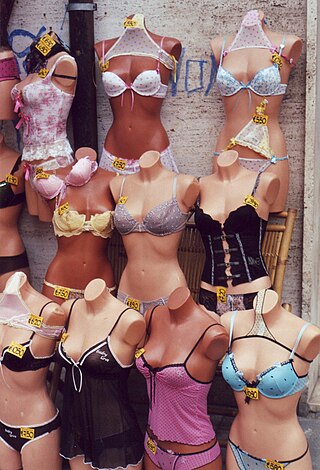
Lingerie is a category of primarily women's clothing including undergarments, sleepwear, and lightweight robes. The choice of the word is often motivated by an intention to imply that the garments are alluring, fashionable, or both. In a 2015 US survey, 75% of women reported having worn "sexy lingerie" in their lifetime.

A corset is a support undergarment worn to hold and train the torso into the desired shape and posture. They are traditionally constructed out of fabric with boning made of whalebone or steel, a stiff panel in the front called a busk which holds the torso rigidly upright, and some form of lacing which allows the garment to be tightened. Corsets were an essential undergarment in European women's fashion from the 17th century to the early 20th century. In the 17th and 18th centuries they were commonly known as "stays" and had a more conical shape. This later evolved into the curvaceous 19th century form which is commonly associated with the corset today. By the beginning of the 20th century, shifting gender roles and the onsets of World War I and II led the corset to be largely discarded by mainstream fashion.
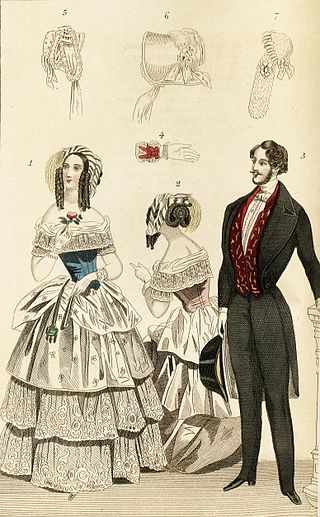
Victorian fashion consists of the various fashions and trends in British culture that emerged and developed in the United Kingdom and the British Empire throughout the Victorian era, roughly from the 1830s through the 1890s. The period saw many changes in fashion, including changes in styles, fashion technology and the methods of distribution. Various movement in architecture, literature, and the decorative and visual arts as well as a changing perception of gender roles also influenced fashion.

A coat is typically an outer garment for the upper body, worn by either gender for warmth or fashion. Coats typically have long sleeves and are open down the front, and closing by means of buttons, zippers, hook-and-loop fasteners, toggles, a belt, or a combination of some of these. Other possible features include collars, shoulder straps, and hoods.

Tightlacing is the practice of wearing a tightly laced corset. It is done to achieve cosmetic modifications to the figure and posture or to experience the sensation of bodily restriction.

A petticoat or underskirt is an article of clothing, a type of undergarment worn under a skirt or a dress. Its precise meaning varies over centuries and between countries.
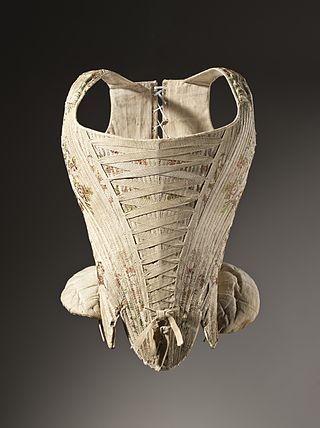
The corset is a supportive undergarment for women, dating, in Europe, back several centuries, evolving as fashion trends have changed and being known, depending on era and geography, as a pair of bodies, stays and corsets. The appearance of the garment represented a change from people wearing clothes to fit their bodies to changing the shape of their bodies to support and fit their fashionable clothing.

1860s fashion in European and European-influenced countries is characterized by extremely full-skirted women's fashions relying on crinolines and hoops and the emergence of "alternative fashions" under the influence of the Artistic Dress movement.

Fashion in the 1890s in European and European-influenced countries is characterized by long elegant lines, tall collars, and the rise of sportswear. It was an era of great dress reforms led by the invention of the drop-frame safety bicycle, which allowed women the opportunity to ride bicycles more comfortably, and therefore, created the need for appropriate clothing.
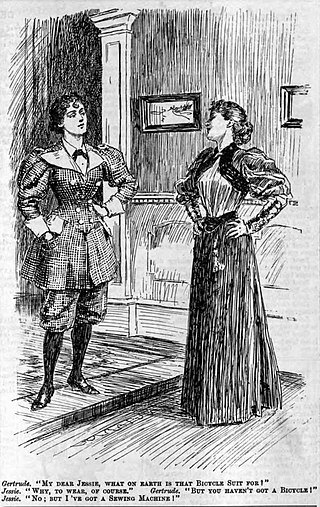
Victorian dress reform was an objective of the Victorian dress reform movement of the middle and late Victorian era, led by various reformers who proposed, designed, and wore clothing considered more practical and comfortable than the fashions of the time.
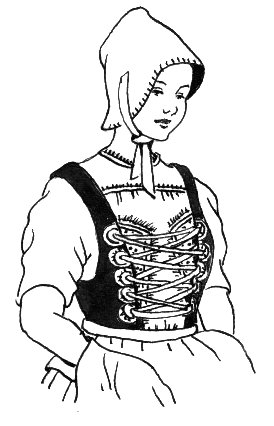
A bodice is an article of clothing traditionally for women and girls, covering the torso from the neck to the waist. The term typically refers to a specific type of upper garment common in Europe during the 16th to the 18th century, or to the upper portion of a modern dress to distinguish it from the skirt and sleeves. The name bodice is etymologically an odd plural spelling of "body" and comes from an older garment called a pair of bodies.

A foundation garment is an undergarment designed to impermanently alter the wearer's body shape, to achieve what some view as a more fashionable figure. The function of a foundation garment is not to enhance a bodily feature but to make it look more presentable.
A dolman is either a military shirt, or a jacket decorated with braiding, first worn by Hungarian hussars. The word is of Turkish origin, and after being adopted into Hungarian, has propagated to other languages. The garment was worn by peasants from the 16th century onward and eventually spread throughout the country, mainly within wealthy peasant circles. It reached people living in the poorest conditions only at the end of the 19th century.

Fashion in the period 1550–1600 in European clothing was characterized by increased opulence. Contrasting fabrics, slashes, embroidery, applied trims, and other forms of surface ornamentation remained prominent. The wide silhouette, conical for women with breadth at the hips and broadly square for men with width at the shoulders had reached its peak in the 1530s, and by mid-century a tall, narrow line with a V-lined waist was back in fashion. Sleeves and women's skirts then began to widen again, with emphasis at the shoulder that would continue into the next century. The characteristic garment of the period was the ruff, which began as a modest ruffle attached to the neckband of a shirt or smock and grew into a separate garment of fine linen, trimmed with lace, cutwork or embroidery, and shaped into crisp, precise folds with starch and heated irons.

An hourglass corset is a garment that produces a silhouette resembling an hourglass shape characterized by wide hips, narrow waist, and wide bust.

The history of bras is closely tied to the social status of women, the evolution of fashion, and shifting views of the female body over time.
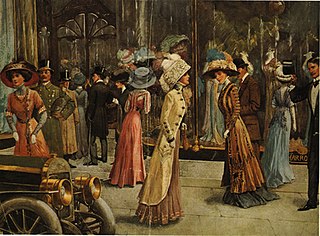
Fashion in the period 1900–1909 in the Western world continued the severe, long and elegant lines of the late 1890s. Tall, stiff collars characterize the period, as do women's broad hats and full "Gibson Girl" hairstyles. A new, columnar silhouette introduced by the couturiers of Paris late in the decade signaled the approaching abandonment of the corset as an indispensable garment.

A dress is a garment traditionally worn by women or girls consisting of a skirt with an attached bodice. It consists of a top piece that covers the torso and hangs down over the legs. A dress can be any one-piece garment containing a skirt of any length, and can be formal or casual.

Underwear, underclothing, or undergarments are items of clothing worn beneath outer clothes, usually in direct contact with the skin, although they may comprise more than a single layer. They serve to keep outer clothing from being soiled or damaged by bodily excretions, to lessen the friction of outerwear against the skin, to shape the body, and to provide concealment or support for parts of it. In cold weather, long underwear is sometimes worn to provide additional warmth. Special types of undergarments have religious significance. Some items of clothing are designed as undergarments, while others, such as T-shirts and certain types of shorts, are appropriate both as underwear and outerwear. If made of suitable material or textile, some underwear can serve as nightwear or swimwear, and some undergarments are intended for sexual attraction or visual appeal.

An overskirt is a type of women's short skirt which is draped over another garment, such as a skirt, breeches, or trousers. Although peplum is often used as another term for overskirt, it should not be confused with the peplos or "peplum dress", which was worn in ancient Greece.


























